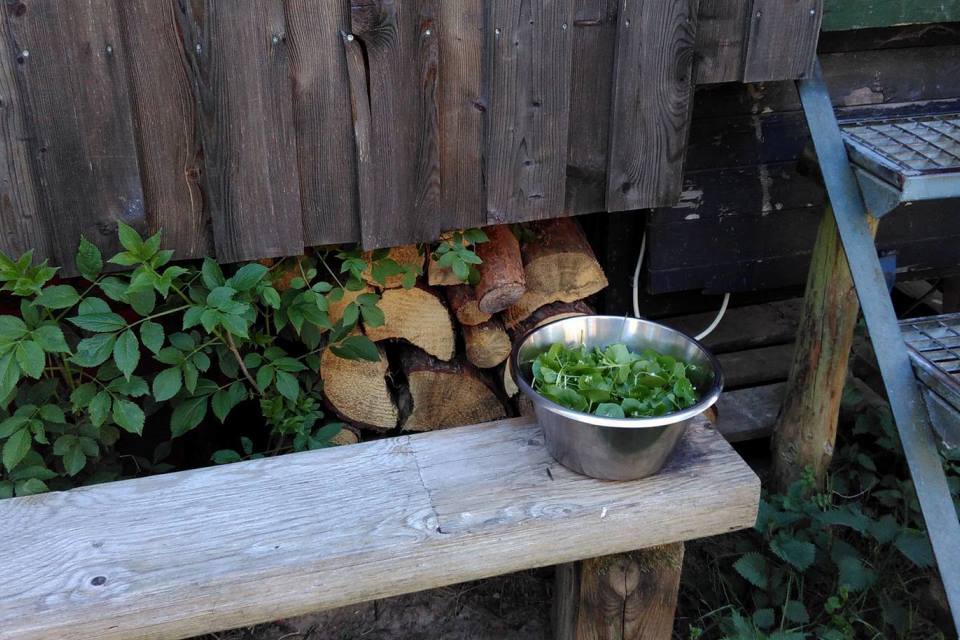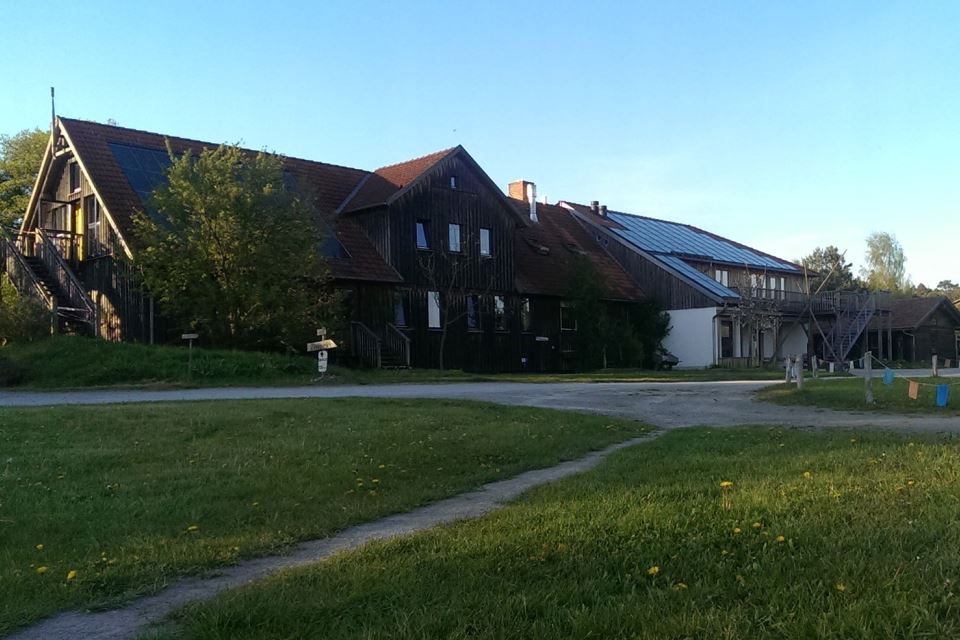Living real alternatives: impressions from an ecovillage
I had a rough idea how the ecovillage ‘Sieben Linden’ in eastern Germany might look like, but I couldn’t guess how strongly it would affect me. An idea, because we already visited an ecovillage in Ireland last year: Cloughjordan about 150 km south-west from Dublin. However, the experiences there are worth their own story, especially since we did this trip together with the other fellows from our studies as ‘global change gang’.
This time we both travelled alone and linked our visit in Sieben Linden to a three-days cycling trip, starting from our current home base Leipzig. In three stages we covered a distance of 280 km with two stopovers, one in Dessau-Roßlau and another in Magdeburg.
Why taking this effort by bike and spending two nights at places, that are not really among the top 10 of most stunning cities in Germany? Well, because we think, that visiting an ecovillage deserves an appropriate journey. Plus we like biking, the route up there was leading us through a beautiful landscape along three rivers and because active holidays are much more exciting anyway. Furthermore, and you should better not underestimate that point, a cold freshly tapped beer tastes even better after biking 85 km than after a train ride.
So it happened that we arrived on the very Friday afternoon in Sieben Linden, slightly exhausted and sweating , with only one goal: Finding Fred, an inhabitant who should show us around. Fortunately, we found him immediately, since Fred was already waiting for us, enjoying his cup of lupine coffee and significantly younger as we expected from an ecovillage-resident with the full name Manfred (a German name of a rather older generation). Directly I realised the comfortable ease Fred radiated and I should learn soon that this peaceful atmosphere was spread all over this place.
Just after arrival, Fred already led us to a first little highlight: A site caravan – our accommodation for the following two nights. I had been looking forward to this since days (Yes, seriously!), because living in a site caravan, has always been a little childhood dream of mine. Probably this correlates to my former addiction to a well-known German TV series called ‘Löwenzahn’ (German for dandelion), where a guy living in a caravan was teaching about nature. Gladly I did another check mark on my still way to long ‘I-want-to-do-in-my-life’ list. And like so often in life, it are the small things that make us happy.
Inside, the caravan was small and cosy, furnished with two single beds and a wood stove that we didn’t need to use during those warm spring days. A toilet was not integrated, but this was not necessary since there were plenty of possibilities outside.
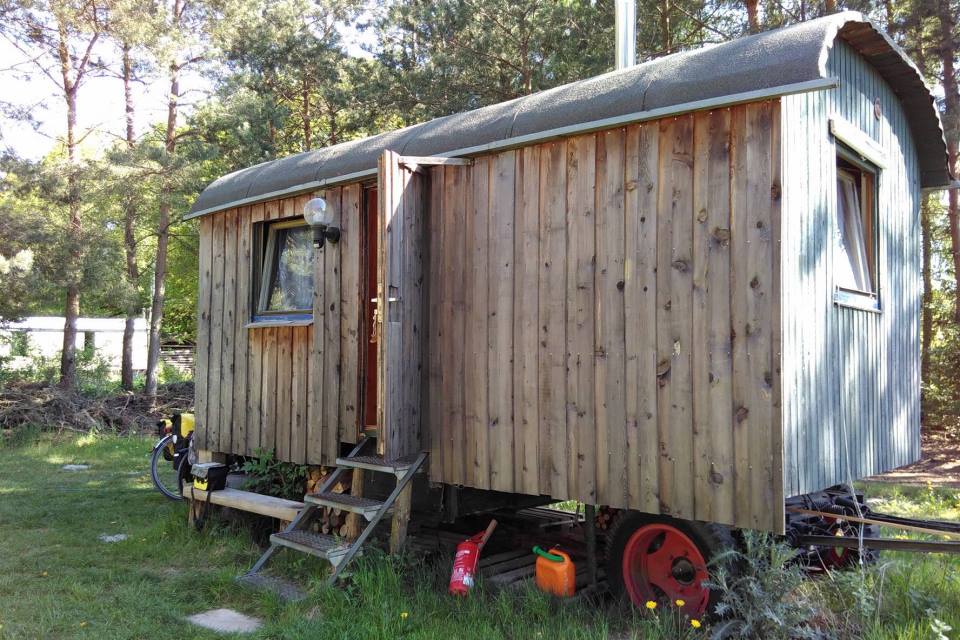
Lovely site caravan: our home for two nights (own photo)
The entire village exclusively provides compost toilets that don’t need a flush. Basically, these are nothing else than privies. From a comfort point of view, they don’t differ much from usual toilets; well, at least not the indoor ones. Lid closed they look exactly the same, the only difference is that they are not connected to a sewerage via water pipes and instead consist of a broad pipe vertically leading to a collecting tank. What goes there is not visible from above. Guaranteed. Adventurous people can find rather typical privies outside: a wooden board, a hole and a wheelbarrow; that’s it. Also something you should at least try once in life. In all variants the – let me put it here as material is collected and professionally stored at a special place outdoor for composting. Give it some time and it will transform to soil – a closed cycle, that saves resources and shows how everything on earth is interconnected.
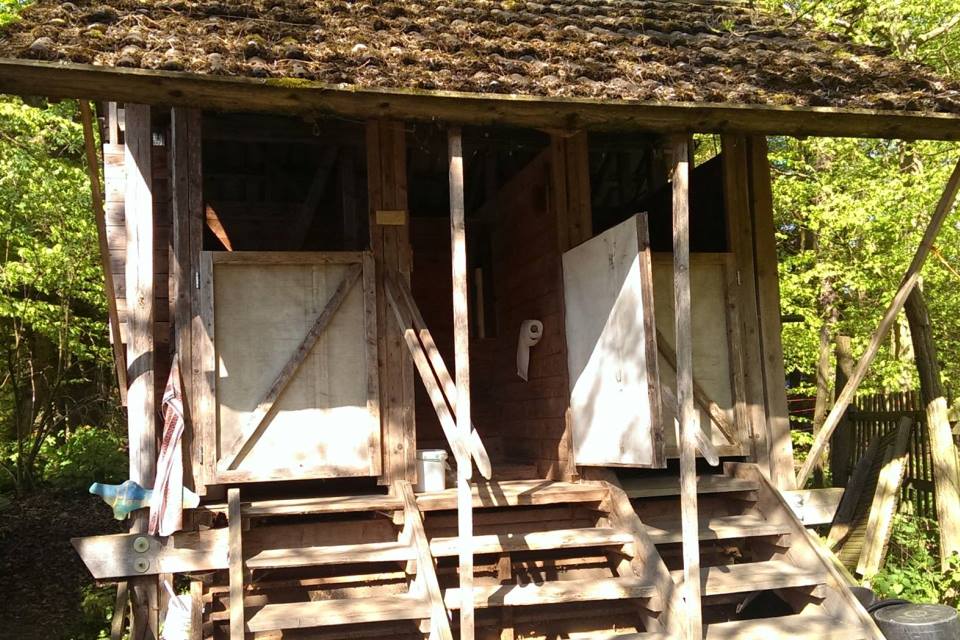 Outdoor privies (own photo)
Outdoor privies (own photo)
Let’s come from toilet to table, particularly to the food on it, one aspect we were really looking forward a lot. Firstly, because we simply love to eat. Secondly, because we already knew that the vegetarian or vegan meals are getting prepared out of organic products, mainly derived from regional or even own agriculture.
The common storage room, we could catch a glimpse of, looks like an organic grocery store and the fields and gardens belonging to the village represent an own little Land of Cockaigne: apple trees, rhubarb, redcurrant bushes, tomato plants, potatoes, salads and much more. Instantly, I felt like returning to this place during main harvesting season and trying all these goodies freshly from the field. Maybe I could do this in combination with a field-working week offered by the village?
As if I was not already fully captured by all these impressions, I realised another, pretty handsome detail in the middle of all this: A young man was standing there, barefoot and naturally tanned, with long dark-blond dreads and dusty skin and was planting offshoots into little boxes with soil. It just looks as if he was destined for being exactly at this place… Shortly, I was wondering, whether I might have had slightly too much lupine coffee and if this could lead to any psychedelic effects.
But no, I am quite sure that this inspiring deep relaxation I felt was real. Everything at this place just made sense to me. Usually, I regularly come across things (or sometimes even people), which drive me nuts because I don’t see any reasonable sense behind it. Not so in Sieben Linden. Nothing there was redundant but nothing was missing either. Everything was in close communion with nature and therefore perfect in a reassuring way.
This also applies to the houses there, which do not look like grass covered hobbit caves (surely this would be nice as well!). They are rather pragmatic artistically designed constructs with a low energy standard, arising from a mixture of modern techniques, artistic freedom and sustainable materials: mostly wood, clay and straw. A top insulation is achieved by straw bales that are integrated within the walls. Solar collectors on the roofs or spread around the area serve for heating as well as for hot water processing and via photovoltaic panels the village also produces significantly more than 50% of the electricity they consume.
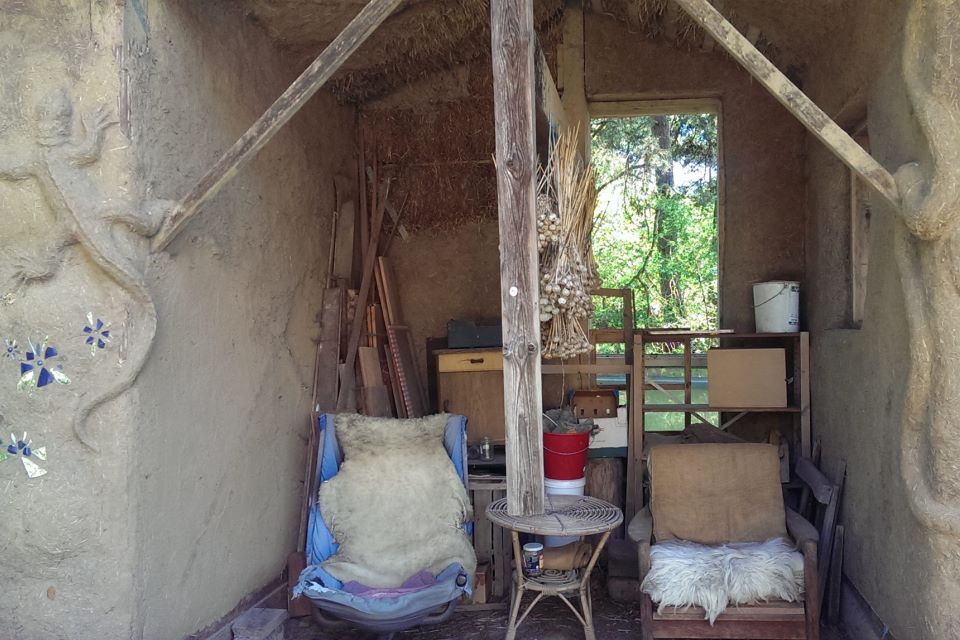
Example house, showing principal building style based on wood, clay and straw (own picture)
common houses with solar panels (own picture)
The entire life in the village is based on strong solidarity. Several families or single persons are sharing houses. Of course, everyone still has some privacy space; however, there are community rooms that are shared by all group members, including a common use of kitchens, washing machines or toilets for instance. Basically this is like a shared flat you may know from your student life, just with the difference that in Sieben Linden this is not an intermediate state, it is much more a fundamental part of the sustainability concept.
Community life there goes far beyond sharing a home. In a common house residents (and visitors) eat together, celebrate or just spent some time with each other. Each resident further is devoted to specific tasks, for instance in the agricultural sector, gardening, cleaning of premises or managing composting. People take responsibility for nature and their fellow (wo)men, support and take care of each other. This is a crucial point, since the community project can only be successful if all pull together.
After all we had seen so far, we were pretty curious about the local Pub on Saturday night. Already guessing what kind of music they will play there, we optimistically bet on 70ies/80ies rock, soft reggae sounds and live guitar music. We were definitely not ready for that, what happened then. Abruptly we found ourselves relegated to moderate late 90ies disco party instead of experiencing an alternative Flower-Power Revival à la Woodstock. The rotating multi-colored mirror ball did not help to defuse the situation. I was indeed a bit disappointed, but well, after all it could not change my general positive impression. If people are doing so good in anything else, a hint of weird nostalgia can be condoned.
In the end, I am convinced that it was not the lupine coffee, but indeed the atmosphere of this place with all of its residents that gave me some release. The community shows all the possibilities we already do have to change something and it further proofs how much of what we call normal in our society, is actually unnecessary. This experience allowed me breathing deeply for two days, far away from city noise, mobile phones, mad rush and overconsumption.
Whether I could imagine living there? Yes and no. 100% yes in terms of sustainability, protection of resources, the compost toilets, own agriculture and life close to nature. I could even live with the multi-colored mirror ball. However, I am not sure regarding to the very strong community life that is also quite secluded. It is difficult for me to commit myself to one thing and I enjoy my personal freedom as well as the flexibility a city offers. Above that, I really love being alone sometimes, having time for myself without the need to take responsibility of other people is pretty important to me.
Living in Sieben Linden would also mean, giving up my restless maybe kind of eccentric lifestyle and dedicating to a strong responsible community. I am not yet ready for this. But who knows? Maybe I will be one day.
Because, if I am honest, I believe that finding back to local communities that show global consciousness and responsibility, is an important milestone humanity needs to set for finally making big changes in this world.

